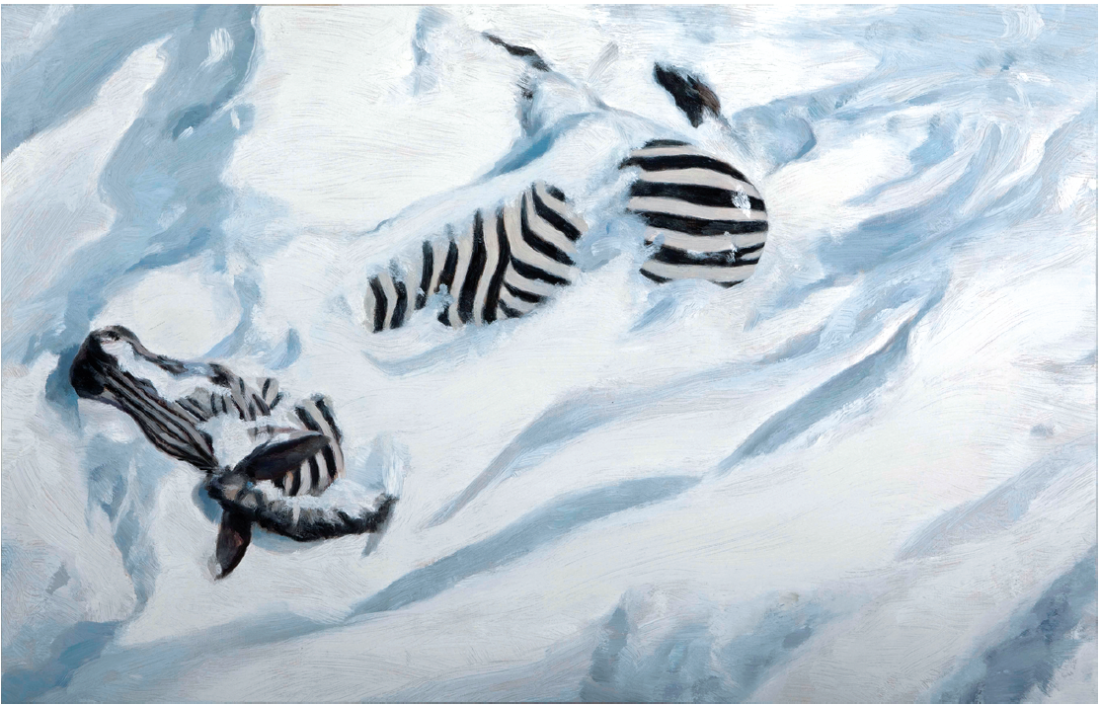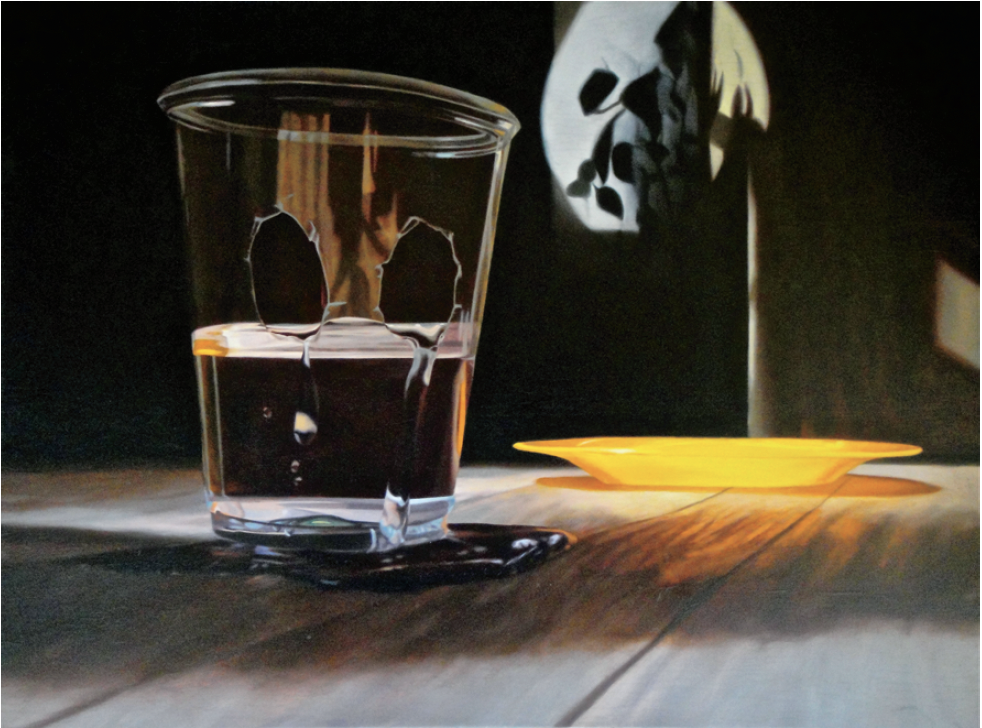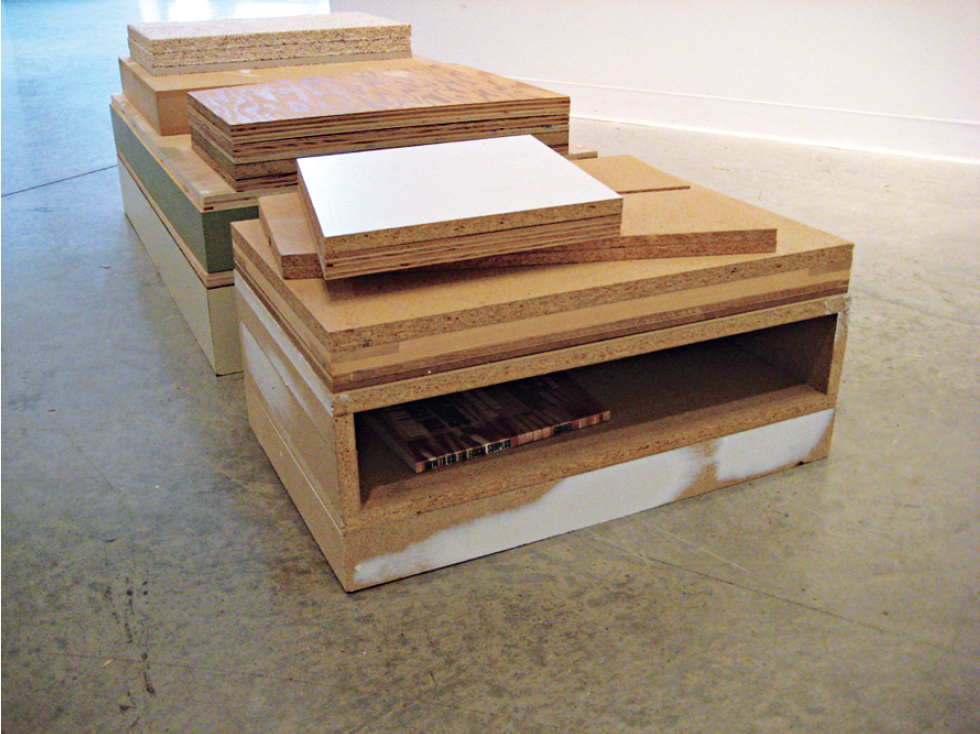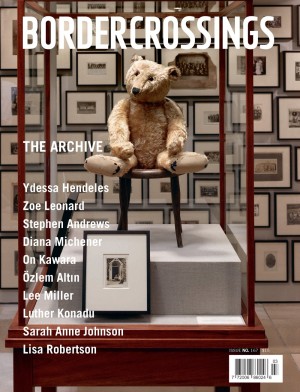“sudden frost”

Will Gorlitz, Always Already (zebra), 2010, oil on panel, 14 x 22”. All images courtesy the artists and Elissa Cristall Gallery, Vancouver.
Through the summer, eight contemporary artists based in Southern Ontario showed at Elissa Cristall Gallery in Vancouver, BC, in a show curated by gallery artist Pete Smith. There was a kinetic, totally charming, emo-conceptual video piece by Jenn E Norton to watch, and an unprepossessing particleboard-slab sculpture by Kevin Rodgers in the middle of the floor to watch out for, but most of the show was dominated by the work on the walls. The room was filled with paintings, prints and drawings—the work of six artists whose approach felt as different from one another as sculpture is to video. If a local geography helped the curator limit the range of artists he chose for the show (a painter, Smith lives in Brooklin, Ontario), then in his essay, Smith is keen to point out his other, more nebulous motive and requirement for his grouping—that is, an urgent sense of modernity. And perhaps a particularly Canadian idea of Modern. “sudden frost,” the title of the show, is a barometric quote borrowed from one of the period’s classic poems, T S Eliot’s “The Waste Land.” The artists were all chosen for work that Smith saw as being in accord with Eliot’s ideas, however distant contemporary London, Ontario, is from Eliot when he wrote the poem. There is in all these artists an urgent sense of time and place—this debt to the present day hangs visibly on these pictures—modernity, at least as Eliot espouses it in the first lines of his Four Quartets, “Burnt Norton”: Time present and time past / Are both perhaps present in time future / And time future contained in time past. / If all time is eternally present / All time is unredeemable. / What might have been is an abstraction / Remaining a perpetual possibility / Only in a world of speculation.

Patrick Mahon, Baker Lake House #5, 2009, silkscreen on Plexiglas, 25.5 x 33”.
These koans by Eliot, one of which is quoted by Smith in his introductory essay, apply to the artists. They do all seek out a sense of the recursive Modern, each in their own way modern, and without being too knackered on pop culture. Norton’s compelling six-minute video, a magical and simple piece, with its cameo from a stuffed toy Tigger by the railroad tracks and themes of camera/identity separation issues, is the most vividly postmodern of the group, but good at it; it identifies a strain of homemade illusion that runs throughout all the work, a trust in that “world of speculation” Eliot spoke of. Nicole Vogelzang’s two photorealistic paintings depict our relationship to illusion, in this case, to our tendency to see faces. In the first, a clear plastic cup of water has had two eyeholes ripped out of its middle and is crying its contents onto the table. The second is more like a lantern, a paper cone with ghost eyes resting on a windowsill. Strangely the pieces that centre this Modernist show are Will Gorlitz’s mordant still-life paintings of exotic animals subjected to a Canadian winter. One is a lovely apricot Ibex frozen to death in a snowdrift; a second painting shows two rhinos having faced the same cold ignominious fate, unable to survive our harsh months. Gorlitz’s handling is fast, not fastidious. Impressively swift, sure swabs of pigment fill in the colouring—flesh’s stiff weight on ice. They are truly strange pictures; even in the fiction that is there, the eye hopes they are toys on a duvet, as the haunting impression of these unnatural naturalist pictures seizes us in the hottest/coldest January of near memory. Gorlitz imports colour in his creatures; his landscapes are slopes of snow.

Nicole Vogelzang, Cup, 2007, oil on board, 18 x 24”.
Patrick Mahon’s screen prints Baker Lake House, #4 and #5 are of a Modernist home in a dark monochrome winter. The thin, seductive grid facade of the Baker Lake House is shown as the negative space eliminated from, safe from, protected from, the darker swarthy conditions of the paper’s storm clouds and violent seacoast textures. Around the corner, David Merritt’s large-scale language drawing is derived from an ant-like path of connections between sayings that use the eternal words, “Never Again.” Kevin Rodgers’s largely monochrome sculpture is a low-to-the-ground salvaged wood stack, a five-foot-long hollowed glacier carved into pieces drifting a little apart, showing a trace of Liz Magor in its elsewhere private meaning. It is abstract sculptural urban recycling, salvage adaptation and assisted readymade, and exciting to see. Sky Glabush reverses his Modern palette and makes a full-spectrum spectacle of the northern colours in his paintings of residential landscapes. In Fence, the cold sky is a livid plum magenta, the big clapboard house is a decaying cyan, the wire fence is a frosty blur like dry contact lenses. The real fence in Glabush’s picture is winter’s grand garden: nature’s leafless trees, shrubs, bushes, tall grass, winter blossoms that thickly surround the house like static or like the frost that grows in tendrils and branches across a window on an especially icy day. Michel Daigneault brings colour, too, and abstraction. A contemporary-hued canvas, using matte, almost muted colours, as if age or pollution has faded the brightest on a Fernand Leger for the electronic music age, in which organic animalistic compounds of mosaic, field, glacier, oil, spaceship, office architecture and ancient petroglyph all defy gravity together. Daigneault’s work doesn’t have much in common with the rest of the works, perhaps a compositional relation to Merritt’s, but this arresting discord and combustion within the works, and a fine unity among them, makes this show a success. ❚

Kevin Rodgers, Qualify & Satisfy, 2010, mixed media, 60 x 23.25 x 16”.
“sudden frost” was exhibited at Elissa Cristall Gallery in Vancouver from July 2 to August 14, 2010.
Lee Henderson is the author of a book of short stories, The Broken Record Technique. His first novel, The Man Game, was published by Penguin Canada in August 2008. He is a Contributing Editor to Border Crossings.

